tire pressure MERCEDES-BENZ SLS AMG GT COUPE 2015 C197 Owner's Manual
[x] Cancel search | Manufacturer: MERCEDES-BENZ, Model Year: 2015, Model line: SLS AMG GT COUPE, Model: MERCEDES-BENZ SLS AMG GT COUPE 2015 C197Pages: 290, PDF Size: 6.24 MB
Page 16 of 290
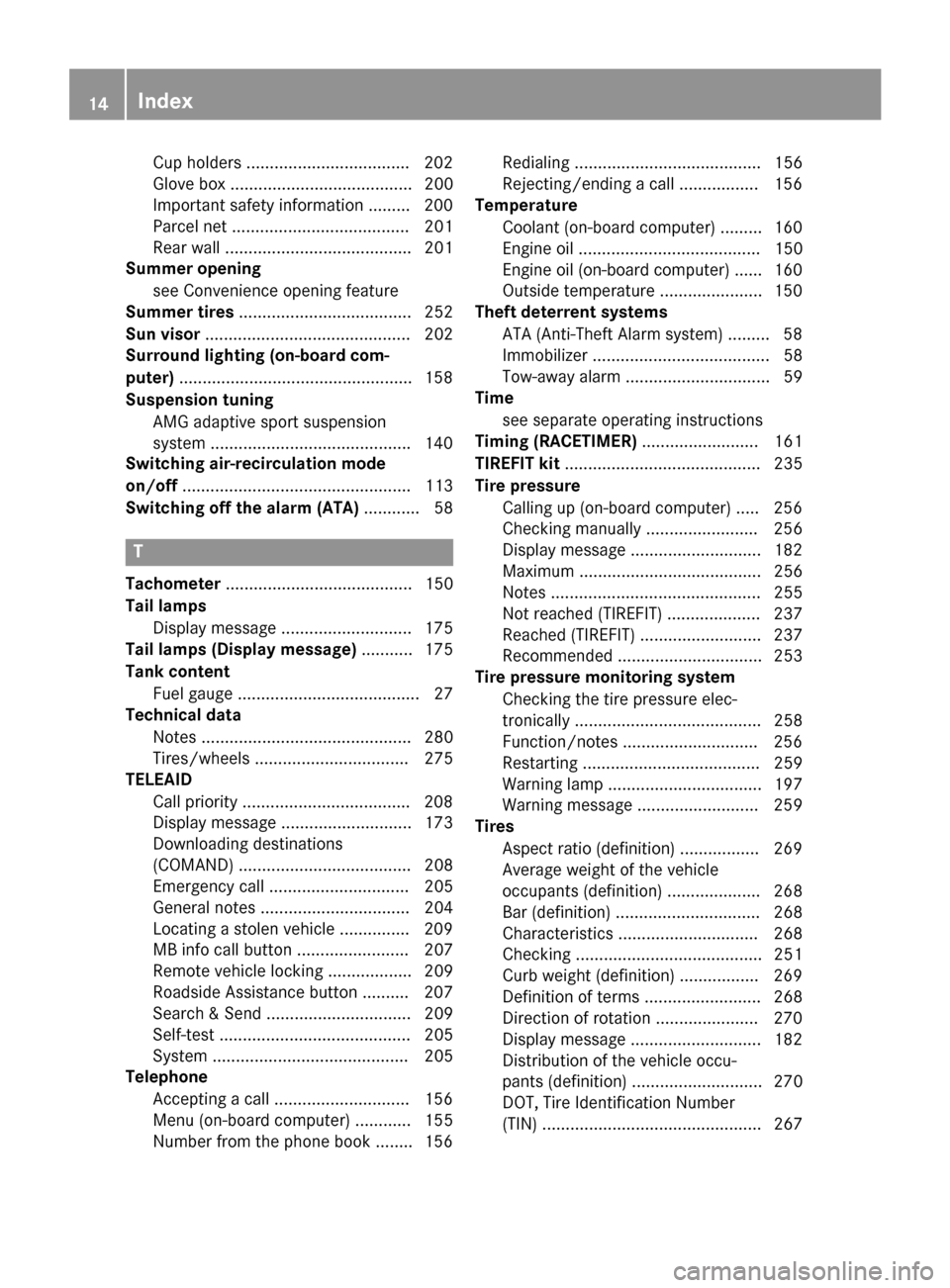
Cup holders ..................................
.202
Glove box ....................................... 200
Important safety information ......... 200
Parce lnet ...................................... 201
Rea rwall. ....................................... 201
Summer opening
see Convenience opening feature
Summer tires ..................................... 252
Sun visor ............................................ 202
Surround lighting (on-board com-
puter) ................................................. .158
Suspensio ntuning
AMG adaptive sport suspension
system .......................................... .140
Switchin gair-recirculation mode
on/off ................................................. 113
Switchin goff the alarm (ATA) ............ 58T
Tachometer ........................................ 150
Tail lamps Display message ............................ 175
Tail lamps (Display message) ........... 175
Tank content Fuel gauge ....................................... 27
Technical data
Notes ............................................. 280
Tires/wheels ................................. 275
TELEAID
Call priority ................................... .208
Display message ............................ 173
Downloading destinations
(COMAND) ..................................... 208
Emergency call .............................. 205
General notes ................................ 204
Locating astole nvehicle .............. .209
MB info call button ........................ 207
Remote vehicle locking .................. 209
Roadside Assistance button .......... 207
Search &Send ............................... 209
Self-test ......................................... 205
System .......................................... 205
Telephone
Accepting acall ............................ .156
Menu (on-board computer) ............ 155
Number from the phone book ....... .156 Redialing ........................................ 156
Rejecting/ending
acall ................. 156
Temperature
Coolant (on-board computer) ......... 160
Engine oil ....................................... 150
Engine oil (on-board computer) ...... 160
Outside temperature ..................... .150
Theft deterren tsystems
ATA (Anti-Theft Alarm system) ......... 58
Immobilize r...................................... 58
Tow-awa yalarm ............................... 59
Time
see separate operating instructions
Timing (RACETIMER) ......................... 161
TIREFIT kit .......................................... 235
Tire pressure Calling up (on-board computer) ..... 256
Checking manually ........................ 256
Display message ............................ 182
Maximum ....................................... 256
Notes ............................................. 255
Not reached (TIREFIT) .................... 237
Reached (TIREFIT) .......................... 237
Recommended ............................... 253
Tire pressure monitoring system
Checking the tire pressure elec-
tronically ........................................ 258
Function/notes ............................ .256
Restarting ...................................... 259
Warning lamp ................................. 197
Warning message .......................... 259
Tires
Aspect ratio (definition) ................. 269
Averag eweight of the vehicle
occupants (definition) .................... 268
Bar (definition) ............................... 268
Characteristics .............................. 268
Checking ........................................ 251
Curb weight (definition) ................. 269
Definition of terms ......................... 268
Direction of rotatio n..................... .270
Display message ............................ 182
Distributio nofthe vehicle occu-
pants (definition) ............................ 270
DOT, Tire Identification Number
(TIN) ............................................... 267 14
Index
Page 17 of 290
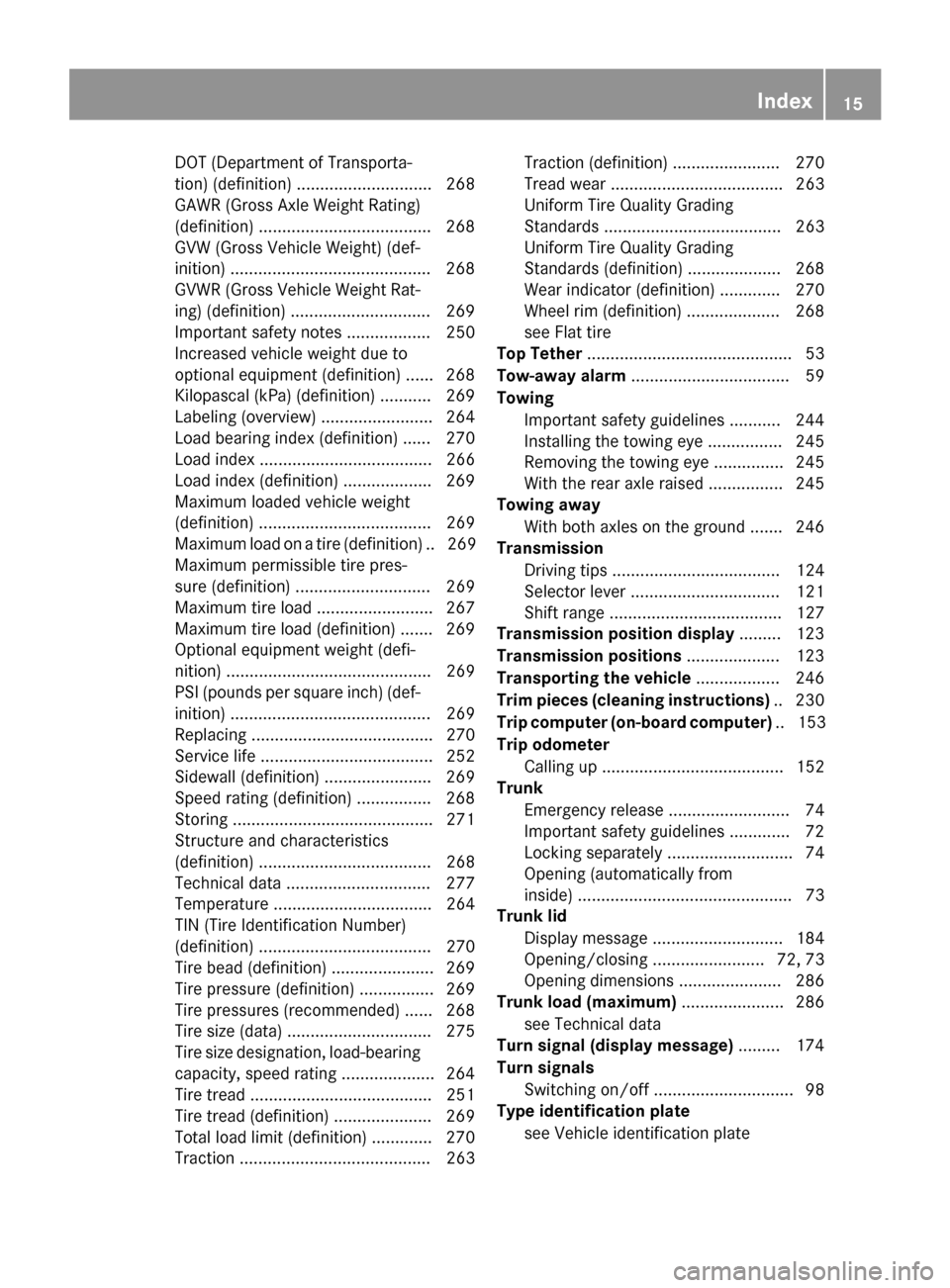
DOT (Department of Transporta-
tion) (definition) ............................. 268
GAW
R(GrossA xle Weight Rating)
(definition) .................................... .268
GVW (Gross Vehicle Weight) (def-
inition) .......................................... .268
GVW R(Gross Vehicle Weight Rat-
ing) (definition) .............................. 269
Important safety notes .................. 250
Increase dvehicle weight due to
optional equipment (definition) ...... 268
Kilopascal (kPa )(definition) ........... 269
Labeling (overview )........................ 264
Loa dbearing index (definition) ...... 270
Loa dindex ..................................... 266
Loa dindex (definition) ................... 269
Maximu mloaded vehicleweight
(definition) ..................................... 269
Maximu mloadona tire (definition) .. 269
Maximu mpermissibl etire pres-
sure (definition) ............................. 269
Maximu mtire load ......................... 267
Maximu mtire load (definition) ....... 269
Optiona lequipment weight (defi-
nition) ............................................ 269
PSI (pounds pe rsquare inch )(de f-
inition) ........................................... 269
Replacing ....................................... 270
Service life ..................................... 252
Sidewal l(de finition) ....................... 269
Speed rating (definition) ................ 268
Storing ........................................... 271
Structure and characteristics
(definition) ..................................... 268
Technica ldata. .............................. 277
Temperature .................................. 264
TIN (Tire Identification Number)
(definition) ..................................... 270
Tire bead (definition) ...................... 269
Tire pressure (definition) ................ 269
Tire pressures (recommended )...... 268
Tire size (data )............................... 275
Tire size designation, load-bearing capacity, speed rating .................... 264
Tire trea d....................................... 251
Tire trea d(definition) ..................... 269
Tota lloa dlim it (definition) ............. 270
Tractio n......................................... 263 Tractio
n(definition) ....................... 270
Tread wear ..................................... 263
Uniform Tire Quality Grading
Standard s...................................... 263
Uniform Tire Quality Grading
Standard s(de finition) .................... 268
Wea rindicator (definition) ............. 270
Wheel rim (definition) .................... 268
see Fla ttire
Top Tether ............................................ 53
Tow-away alarm .................................. 59
Towing Important safety guideline s........... 244
Installing the towing ey e................ 245
Removing the towing ey e............... 245
With the rea raxler aised ................ 245
Towin gaway
With both axles on the ground ....... 246
Transmission
Driving tip s.................................... 124
Selector lever ................................ 121
Shift rang e..................................... 127
Transmissio nposition display ......... 123
Transmissio npositions .................... 123
Transporting the vehicle .................. 246
Trim piece s(clea ning instructions) .. 230
Trip computer (on-board computer) .. 153
Trip odometer Calling up ....................................... 152
Trunk
Emergency release .......................... 74
Important safety guideline s............. 72
Locking separatel y........................... 74
Opening (automatically from
inside ).............................................. 73
Trunk lid
Displa ymessage ............................ 184
Opening/closing ........................ 72, 73
Opening dimensions ...................... 286
Trunk load (maximum) ...................... 286
see Technical data
Turn signal (display message) ......... 174
Turn signals Switching on/of f.............................. 98
Type identificatio nplate
see Vehicl eide ntification plate Index
15
Page 18 of 290
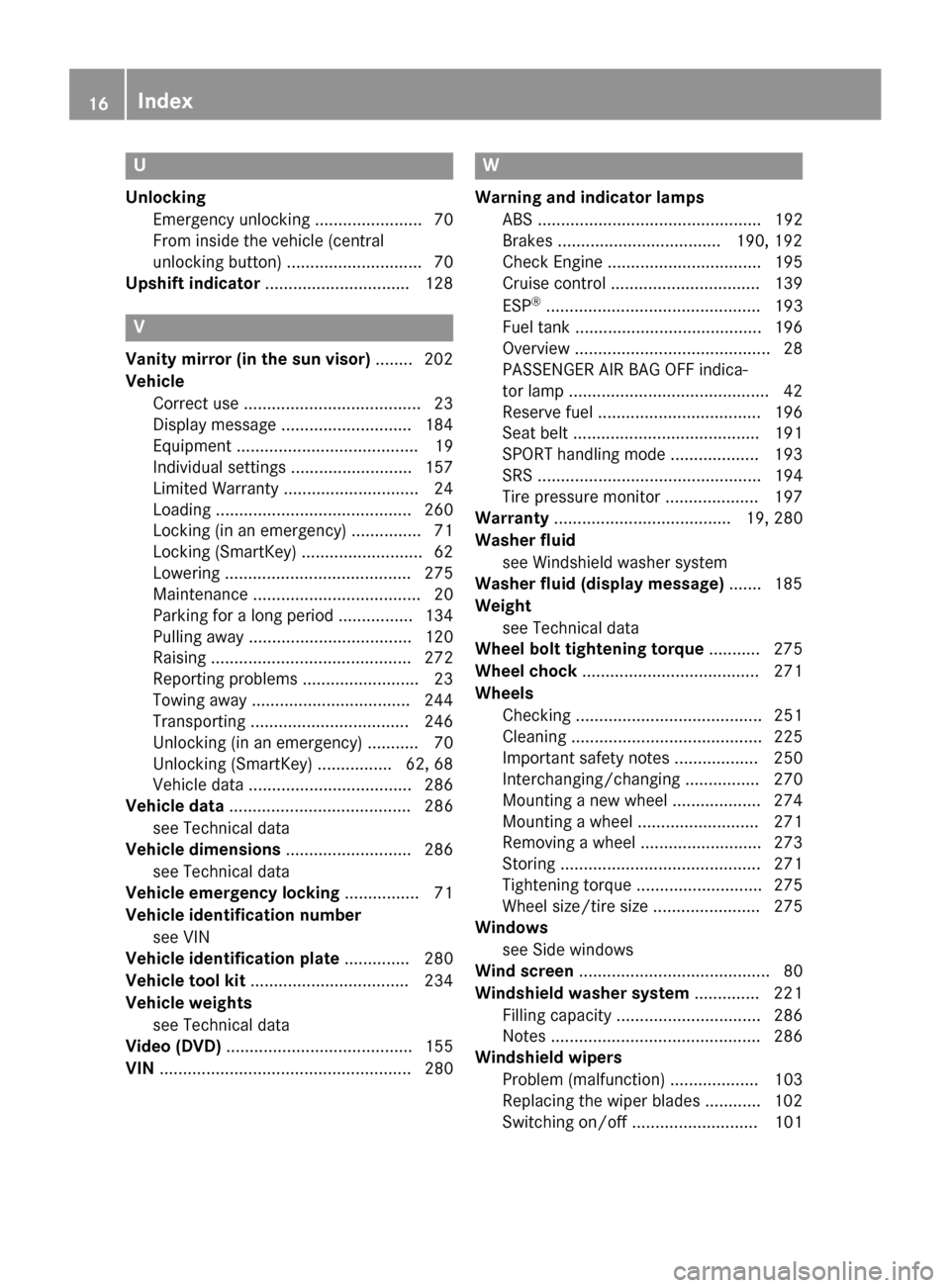
U
Unlocking Emergenc yunlocking .......................70
From inside the vehicle (central
unlocking button) ............................. 70
Upshift indicator ............................... 128V
Vanity mirror (i nthe sun visor) ........ 202
Vehicle Correct us e...................................... 23
Displa ymessag e............................ 184
Equipment ....................................... 19
Individua lsettings .......................... 157
Limite dWarranty ............................. 24
Loading .......................................... 260
Locking (i nanemergency) ............... 71
Locking (SmartKey ).......................... 62
Lowering ........................................ 275
Maintenance .................................... 20
Parking for alon gp eriod. ............... 134
Pulling away ................................... 120
Raising ........................................... 272
Reporting problems ......................... 23
Towing away .................................. 244
Transporting .................................. 246
Unlocking (i nanemergency) ........... 70
Unlocking (SmartKey )................ 62, 68
Vehicl edata. .................................. 286
Vehicl edata ....................................... 286
see Technica ldata
Vehicl edimensions ........................... 286
see Technica ldata
Vehicl eemergenc yloc king ................ 71
Vehicl eidentificatio nnumber
see VIN
Vehicl eidentificatio nplate .............. 280
Vehicl etoolkit.................................. 234
Vehicl eweigh ts
see Technica ldata
Vide o(DV D)........................................ 155
VIN ...................................................... 280 W
Warning and indicator lamps ABS ................................................ 192
Brakes ................................... 190 ,192
Check Engine ................................. 195
Cruise control ................................ 139
ESP ®
.............................................. 193
Fue ltank ........................................ 196
Overview .......................................... 28
PASSENGER AIR BAG OFF indica-
tor lamp ........................................... 42
Reserve fue l................................... 196
Sea tbelt. ....................................... 191
SPOR Thandling mod e................... 193
SRS ................................................ 194
Tire pressure monitor .................... 197
Warranty ...................................... 19, 280
Washer fluid see Windshield washe rsystem
Washer fluid (display message) ....... 185
Weight see Technical data
Wheel bolt tightenin gtorque ........... 275
Wheel chock ...................................... 271
Wheels Checking ........................................ 251
Cleaning ......................................... 225
Important safety notes .................. 250
Interchanging/changing ................ 270
Mounting anew whee l................... 274
Mounting awheel .......................... 271
Removing awheel .......................... 273
Storing ........................................... 271
Tightening torque ........................... 275
Wheel size/tire size ....................... 275
Windows
see Sid ewindows
Win dscreen ......................................... 80
Windshiel dwasher system .............. 221
Filling capacity ............................... 286
Note s............................................. 286
Windshiel dwipers
Problem (malfunction) ................... 103
Replacing the wipe rblade s............ 102
Switching on/of f........................... 101 16
Index
Page 20 of 290
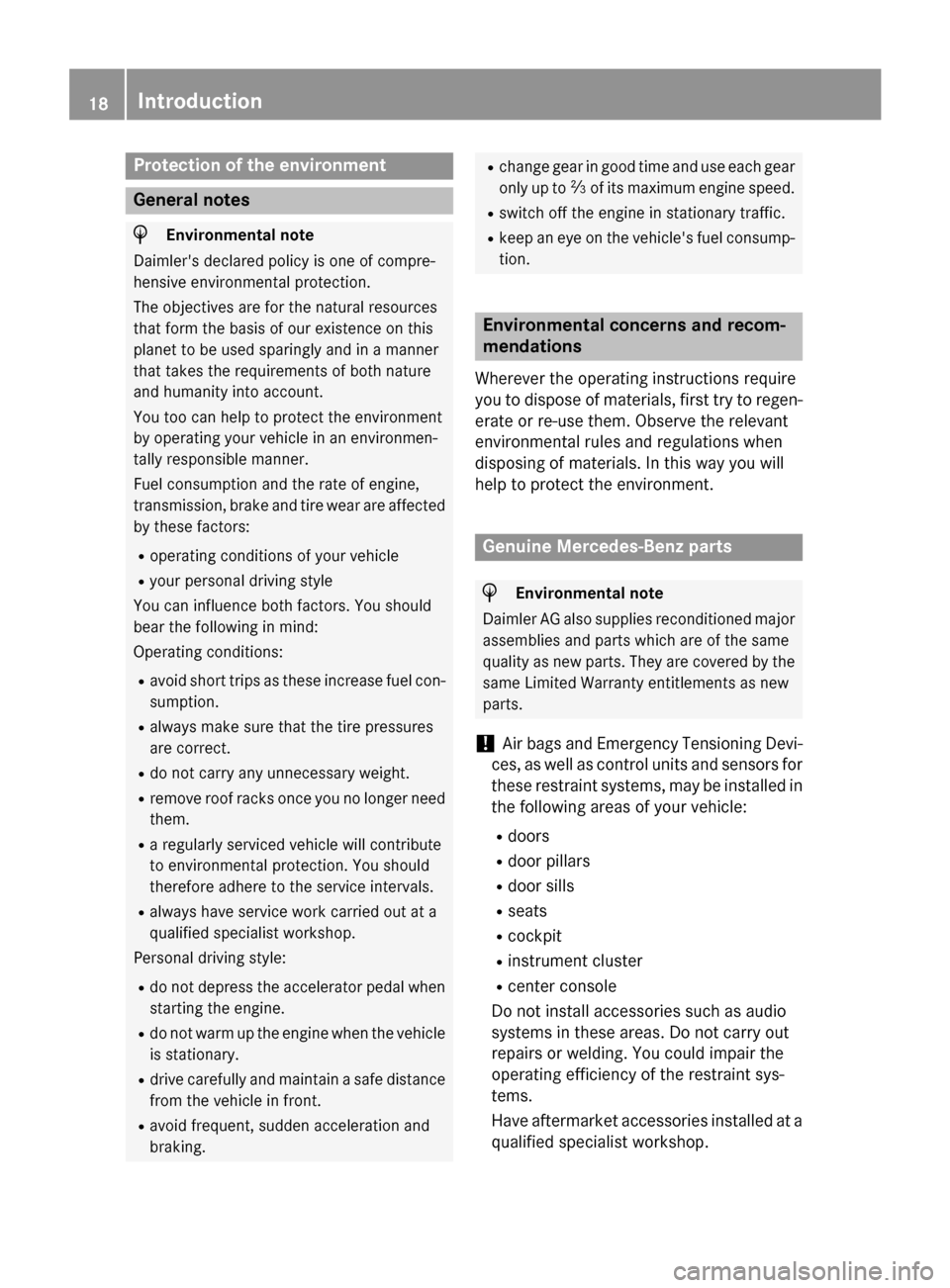
Protection of the environment
General notes
H
Environmental note
Daimler's declared policy is one of compre-
hensive environmental protection.
The objectives are for the natural resources
that form the basis of our existence on this
planet to be used sparingly and in amanner
that takes the requirements of both nature
and humanity into account.
You too can help to protect the environment
by operating your vehicle in an environmen-
tally responsible manner.
Fuel consumption and the rate of engine,
transmission, brake and tire wear are affected by these factors:
R operating condition sofyour vehicle
R your personal driving style
You can influence both factors. You should
bear the following in mind:
Operating conditions:
R avoid short trips as these increase fuel con-
sumption.
R always make sure that the tire pressures
are correct.
R do not carry any unnecessary weight.
R remove roof racks once you no longer need
them.
R ar egularly serviced vehicle will contribute
to environmental protection. You should
therefore adhere to the service intervals.
R always have service work carried out at a
qualified specialist workshop.
Personal driving style:
R do not depress the accelerator pedal when
startingt he engine.
R do not warm up the engine when the vehicle
is stationary.
R drive carefully and maintain asafe distance
from the vehicle in front.
R avoid frequent, sudden acceleration and
braking. R
change gear in good time and use each gear
only up to 00C3of its maximum engine speed.
R switch off the engine in stationary traffic.
R keep an eye on the vehicle's fuel consump-
tion. Environmental concerns and recom-
mendations
Wherever the operating instructions require
you to dispose of materials, first try to regen-
erate or re-use them. Observe the relevant
environmental rules and regulations when
disposing of materials. In this way you will
help to protect the environment. Genuine Mercedes-Benz parts
H
Environmental note
Daimler AG also suppliesr econditioned major
assemblies and parts which are of the same
quality as new parts. They are covered by the same Limited Warranty entitlements as new
parts.
! Air bags and Emergency Tensioning Devi-
ces, as well as control units and sensors for these restraint systems, may be installed inthe following areas of your vehicle:
R doors
R door pillars
R door sills
R seats
R cockpit
R instrumen tcluster
R center console
Do not install accessories such as audio
systems in these areas. Do not carry out
repairs or welding. You could impair the
operating efficienc yofthe restraint sys-
tems.
Have aftermarket accessories installed at a qualified specialist workshop. 18
Introduction
Page 30 of 290
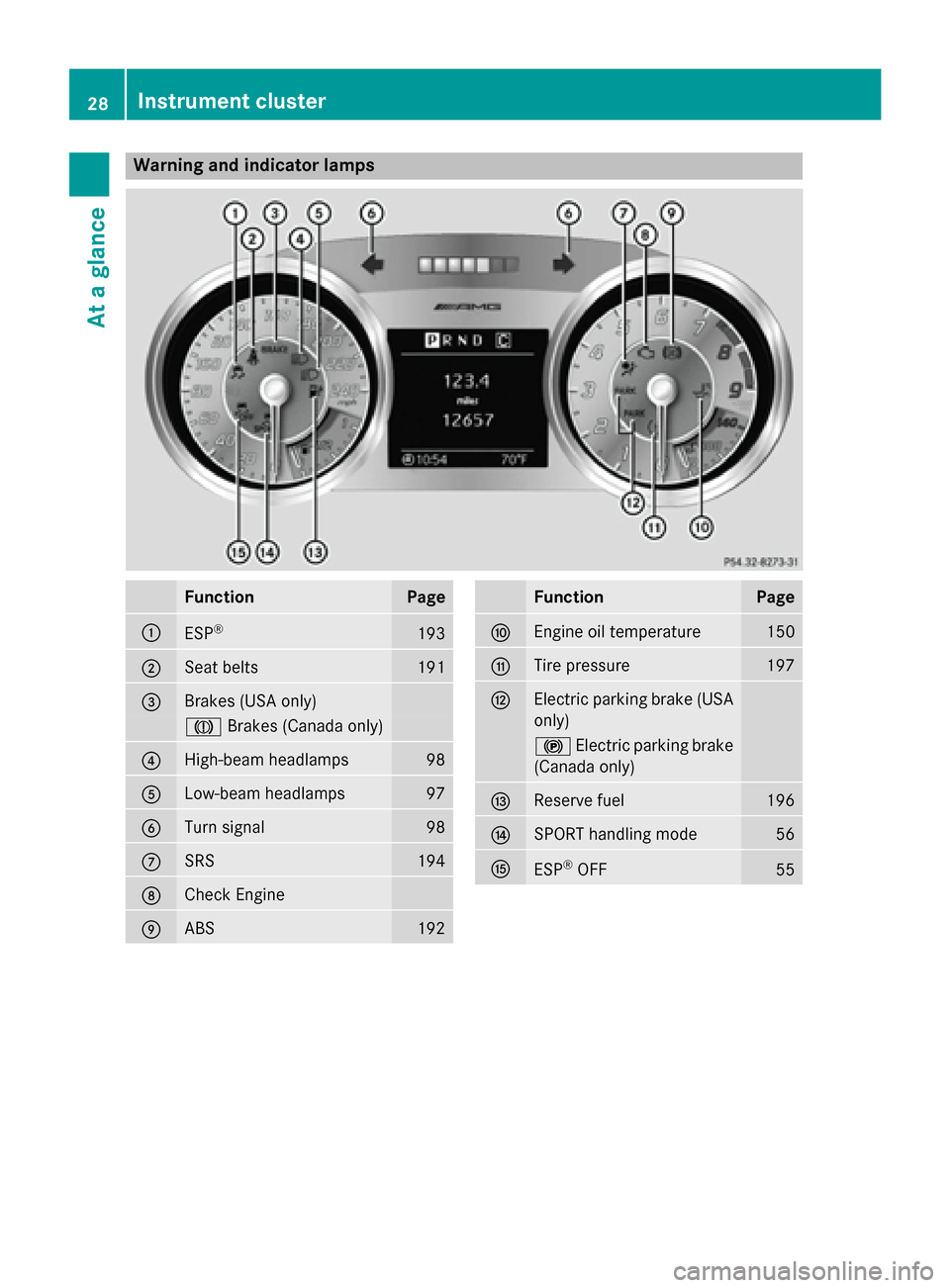
Warning and indicator lamps
Function Page
0043
ESP
® 193
0044
Seat belts 191
0087
Brakes (USA only)
004D
Brakes (Canada only) 0085
High-beam headlamps 98
0083
Low-beam headlamps 97
0084
Turn signal 98
006B
SRS 194
006C
Check Engine
006D
ABS 192 Function Page
006E
Engine oil temperature 150
006F
Tire pressure 197
0070
Electric parking brake (USA
only) 0024
Electric parking brake
(Canada only) 0071
Reserve fuel 196
0072
SPORT handling mode 56
0073
ESP
®
OFF 5528
Instrument clusterAt
ag lance
Page 56 of 290
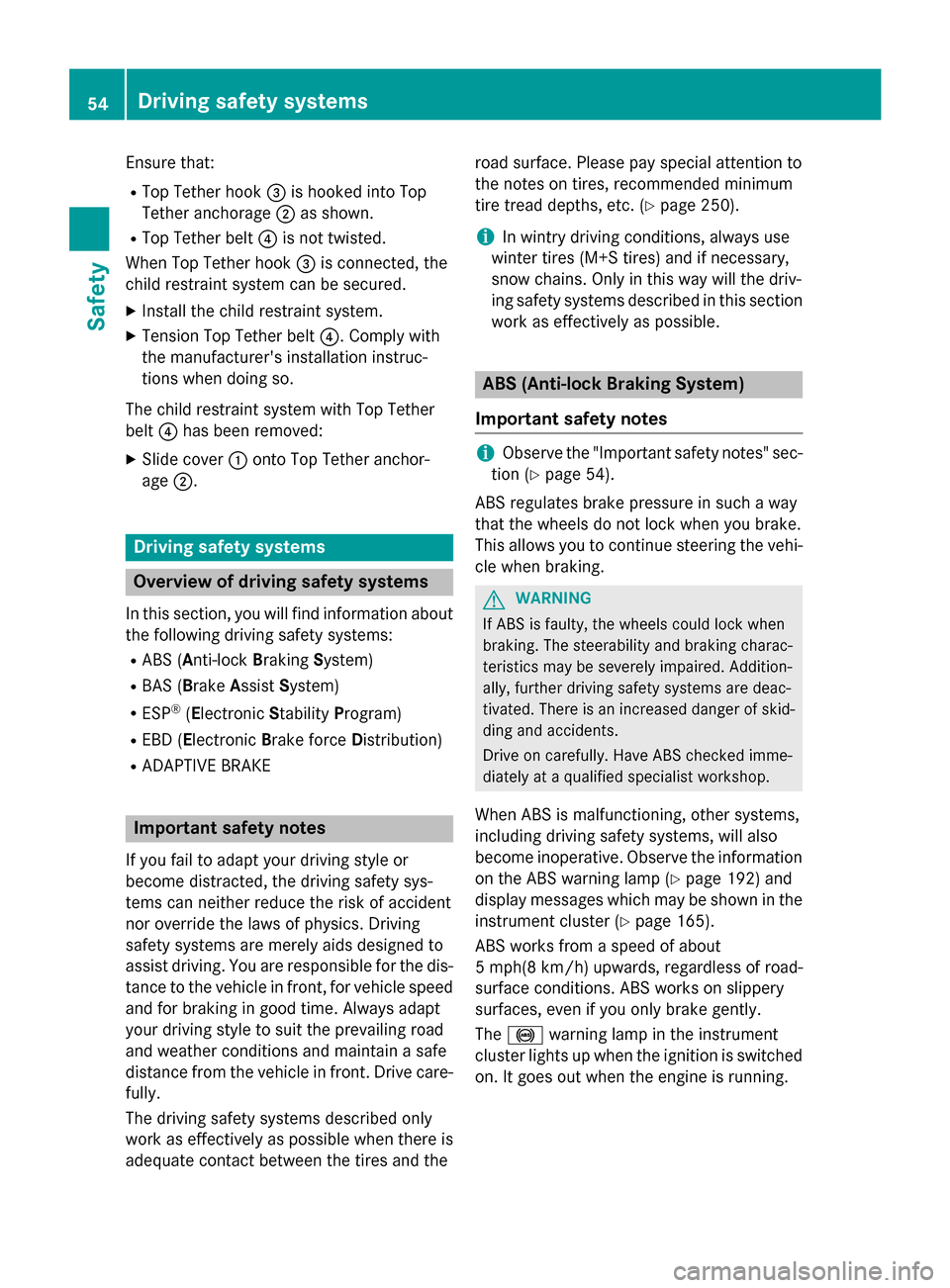
Ensure that:
R To pT ethe rh ook 0087is hooke dinto Top
Tethe ranchorage 0044as shown.
R To pT ethe rb elt 0085 is not twisted.
When To pTethe rh ook 0087is connected ,the
child restraint syste mcan be secured.
X Install the child restraint system.
X Tension To pTethe rb elt 0085.C om plyw ith
the manufacturer's installatio ninstruc-
tions when doing so.
Th ec hild restraint syste mwithT op Tether
belt 0085hasb eenr emoved:
X Slide cover 0043onto To pTethe ra nchor-
age 0044. Driving safety systems
Overvie
wofdrivingsafety systems
In thi ssection, yo uwillf in di nformation about
the following driving safety systems:
R ABS ( Anti-lock Braking System)
R BAS ( Brake Assist Sys tem)
R ESP ®
(Ele ctronic Stability Program)
R EBD ( Electronic Brake force Distribution)
R ADAPTIVE BRAKE Important safety notes
If yo ufailtoa dapt your driving style or
become distracted ,the driving safety sys-
tems can neithe rreduce the risk of accident
nor override the laws of physics .Driving
safety systems ar emerel yaidsd esig nedto
assist driving. Yo uareresponsibl efor the dis-
tance to the vehicl einfront, for vehicl espeed
and for braking in good time. Alway sadapt
your driving style to suit the prevailing road
and weather conditions and maintain asafe
distance fro mthe vehicl einfront. Drive care-
fully.
Th ed riving safety systems describe donly
work as effectivel yaspossibl ew hent here is
adequate contact between the tires and the roa
dsurface. Please pa yspecial attentio nto
the note sontires,recommended minimum
tir et rea ddepths, etc. (Y page 250).
i In wintry driving conditions
,alway suse
winter tires (M+S tires )and if necessary,
sno wchains .Onlyint hisw aywill the driv-
ing safety systems describe dinthiss ection
work as effectivel yaspossible. ABS (Anti-lock Braking System)
Important safety notes i
Observe the "Important safety notes" sec-
tio n(Ypage 54).
ABS regulate sbrake pressure in such away
tha tthe wheels do not lock when yo ubrake.
This allows yo utocontinue steering the vehi-
cle when braking. G
WARNING
If ABS is faulty, the wheels could lock when
braking .The steerability and braking charac-
teristics ma ybeseverel yimpaired. Addition-
ally ,fur the rdriving safety systems ar edeac-
tivated. There is an increase ddangerofs kid-
ding and accidents.
Drive on carefully. Have ABS checked imme-
diately at aquali fied specialis tworkshop.
When ABS is malfunctioning ,other systems,
including driving safety systems, will also
become inoperative. Observe the information on the ABS warning lamp (Y page 192)and
displa ymessage swhich ma ybeshown in the
instrument cluste r(Ypage 165).
ABS works fro maspeed of about
5m ph(8 km/h) upwards ,regardles sofroad-
surface conditions .ABS works on slippery
surfaces ,evenify ouonlybrake gently.
The 0025 warning lamp in the instrument
cluste rlight supw hent he ignition is switched
on. It goes ou twhent he engine is running. 54
Driving safet
ysystemsSafety
Page 131 of 290
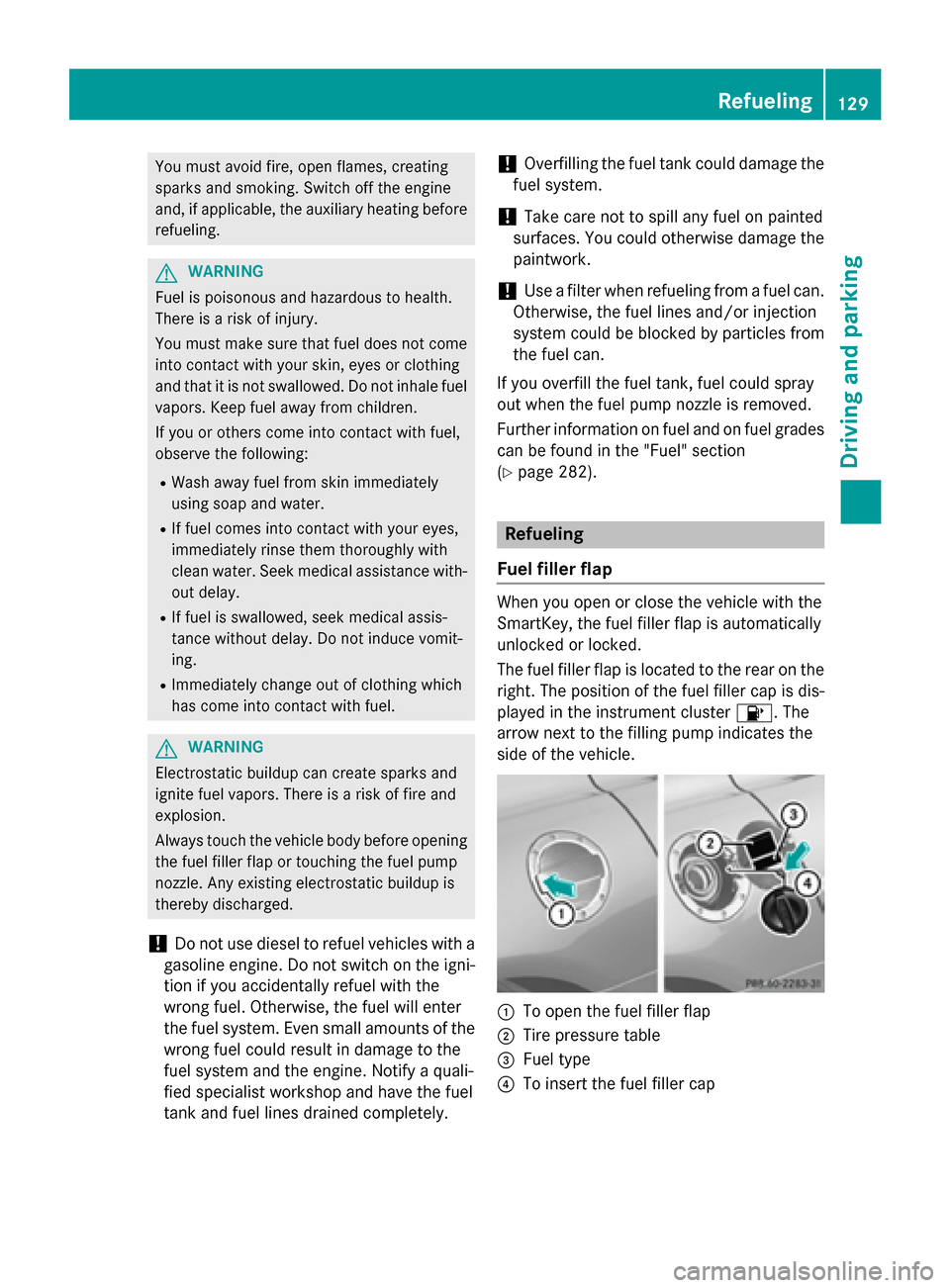
You must avoid fire, open flames
,creating
spark sand smoking. Switch off the engine
and, if applicable, the auxiliary heatin gbefore
refueling. G
WARNING
Fuel is poisonous and hazardous to health.
There is arisk of injury.
You must make sure that fuel does not come int oc ontac twith your skin ,eyes or clothing
and that it is not swallowed. Do not inhale fuel
vapors .Keep fuel away from children.
If you or others com eintoc ontac twith fuel,
observ ethe following:
R Wash away fuel from skin immediately
using soap and water.
R If fuel comes int ocontac twith your eyes,
immediately rinse the mthoroughly with
clean water. Seek medical assistanc ewith-
out delay.
R If fuel is swallowed, seek medical assis-
tance without delay. Do not induc evomit-
ing.
R Immediately change out of clothing which
has com eintoc ontac twith fuel. G
WARNING
Electrostatic buildup can create spark sand
ignit efuel vapors .There is arisk of fire and
explosion.
Always touc hthe vehicle body befor eopening
the fuel filler flap or touching the fuel pump
nozzle. An yexisting electrostatic buildup is
thereby discharged.
! Do not use diesel to refuel vehicles with a
gasolin eengine. Do not switc honthe igni-
tion if you accidentally refuel with the
wron gfuel. Otherwise, the fuel will enter
the fuel system. Even small amount softhe
wron gfuel could result in damage to the
fuel syste mand the engine. Notify aquali-
fied specialis tworkshop and have the fuel
tan kand fuel lines draine dcompletely. !
Overfilling the fuel tan
kcould damage the
fuel system.
! Take care not to spill any fuel on painted
surfaces. You could otherwise damage the paintwork.
! Use
afilter when refuelin gfrom afuel can.
Otherwise, the fuel lines and/or injection
syste mcould be blocked by particles from
the fuel can.
If you overfill the fuel tank, fuel could spray
out when the fuel pump nozzle is removed.
Further information on fuel and on fuel grades can be foun dinthe "Fuel" section
(Y page 282). Refueling
Fuel filler flap When you open or close the vehicle with the
SmartKey, the fuel filler flap is automatically
unlocked or locked.
The fuel filler flap is located to the rear on the right .The position of the fuel filler cap is dis-
played in the instrumen tcluster 00B6.T he
arrow nex ttothe filling pump indicates the
side of the vehicle. 0043
To open the fuel filler flap
0044 Tire pressure table
0087 Fuel type
0085 To inser tthe fuel filler cap Refueling
129Driving and parking Z
Page 137 of 290
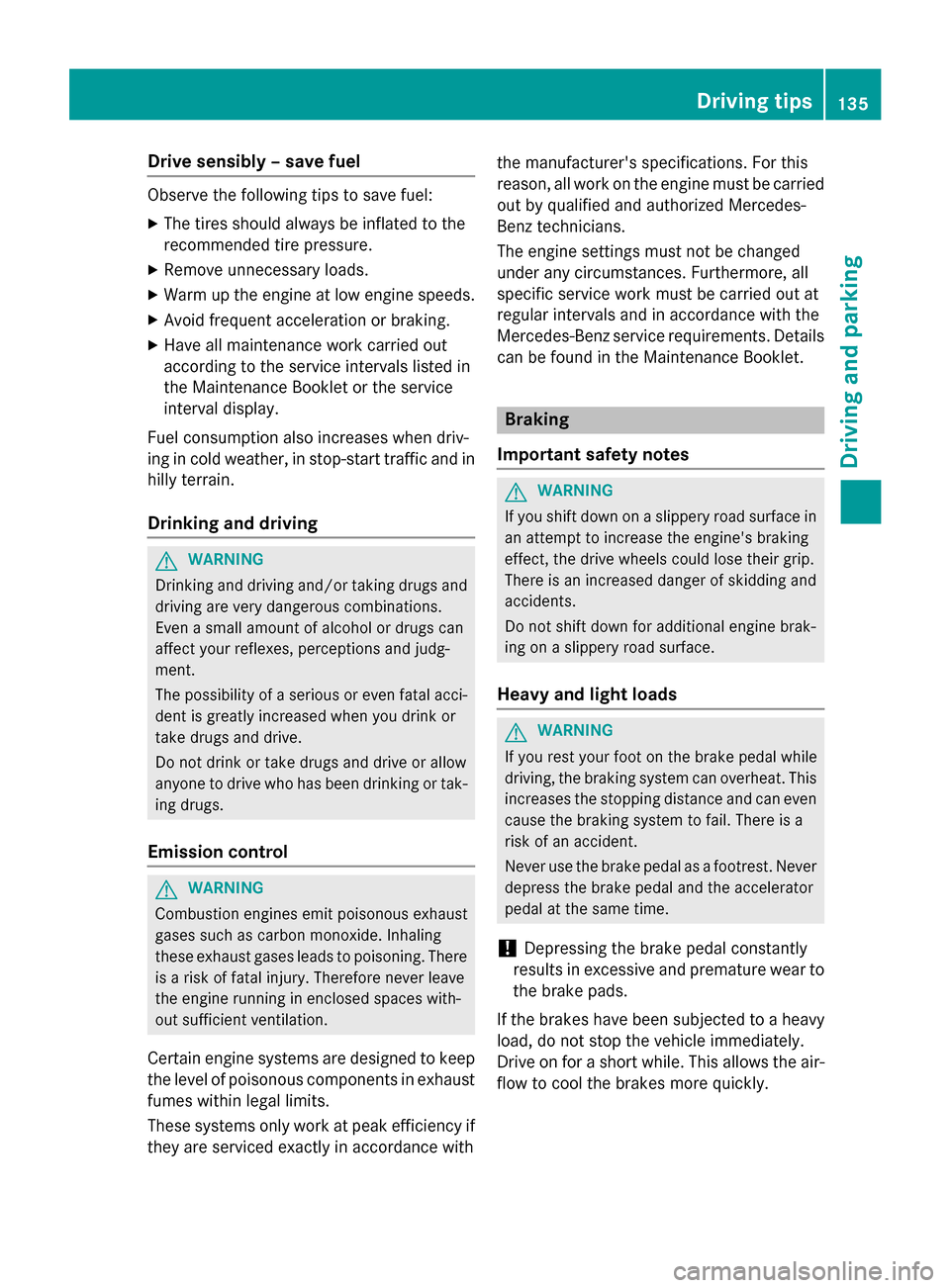
Drive sensibly
–savef uel Observ
ethe following tips to sav efuel:
X The tires should always be inflated to the
recommended tire pressure.
X Remov eunnecessary loads.
X War mupt heengin eatlow engin espeeds.
X Avoid frequent acceleration or braking.
X Hav eall maintenance wor kcarrie dout
accordin gtotheservic einterva ls listed in
th eM aintenance Booklet or th eservice
interval display.
Fue lconsu mption also increase swhen driv-
in ginc oldw eather ,instop-start traffic and in
hill yterra in.
Drinking an ddriving G
WARNING
Drinking and drivin gand/o rtaking drugs and
drivin gare ver ydangerous combinations.
Even asma ll amount of alcoho lordrugs can
affec tyour reflexes, perception sand judg-
ment.
The possibilit yofas erious or eve nfatal acci-
den tisg reatly increase dwhen you drink or
take drugs and drive.
Do no tdrink or take drugs and drive or allow
anyon etodrive who has bee ndrinkin gortak-
in gd rugs.
Emission control G
WARNING
Combustion engines emi tpoisonous exhaust
gases suc hascarbon monoxide. Inhaling
these exhaus tgases lead stopoisoning. There
is ar iskoff atal injury. Therefor enever leave
th ee nginer unning in enclose dspaces with-
out sufficien tventilation.
Certain engin esystems are designed to keep
th el evel of poisonous component sinexhaust
fumes within lega llimits.
These systems only wor katpeak efficiency if
they are serviced exactly in accordance with th
em anufacturer's specifications. Fo rthis
reason ,all wor kont heengin emustbec arried
out by qualified and authorized Mercedes-
Benz technicians.
The engin esetting smustn otbe changed
under any circumstances. Furthermore, all
specific servic eworkm ustbec arriedout at
regular intervals and in accordance wit hthe
Mercedes-Ben zservic erequirements .Detai ls
can be found in th eMaintenance Booklet. Braking
Important safet ynotes G
WARNING
If you shift down on aslipper yroads urfac ein
an attempt to increase th eengine's braking
effect ,the drive wheels could los etheir grip.
There is an increase ddanger of skidding and
accidents.
Do no tshift down fo radditional engin ebrak-
in gonas lipperyroads urface.
Heavy an dligh tloads G
WARNING
If you res tyour foot on th ebrake peda lwhile
driving, th ebraking system can overheat .This
increase sthe stoppin gdistanc eand can even
cause th ebraking system to fail .There is a
ris kofana ccident.
Never use th ebrake peda lasafootrest. Never
depress th ebrake peda land th eaccelerator
peda latthesam etime.
! Depressing th
ebrake peda lconstantly
result sinexcessive and premature wear to
th eb rake pads.
If th ebrake shaveb een subjecte dtoa heavy
load ,don otstop th evehicle immediately.
Drive on fo rashort while. Thi sallow sthe air-
flo wt ocoolthe brake smoreq uickly. Driving tips
135Driving andpark ing Z
Page 159 of 290
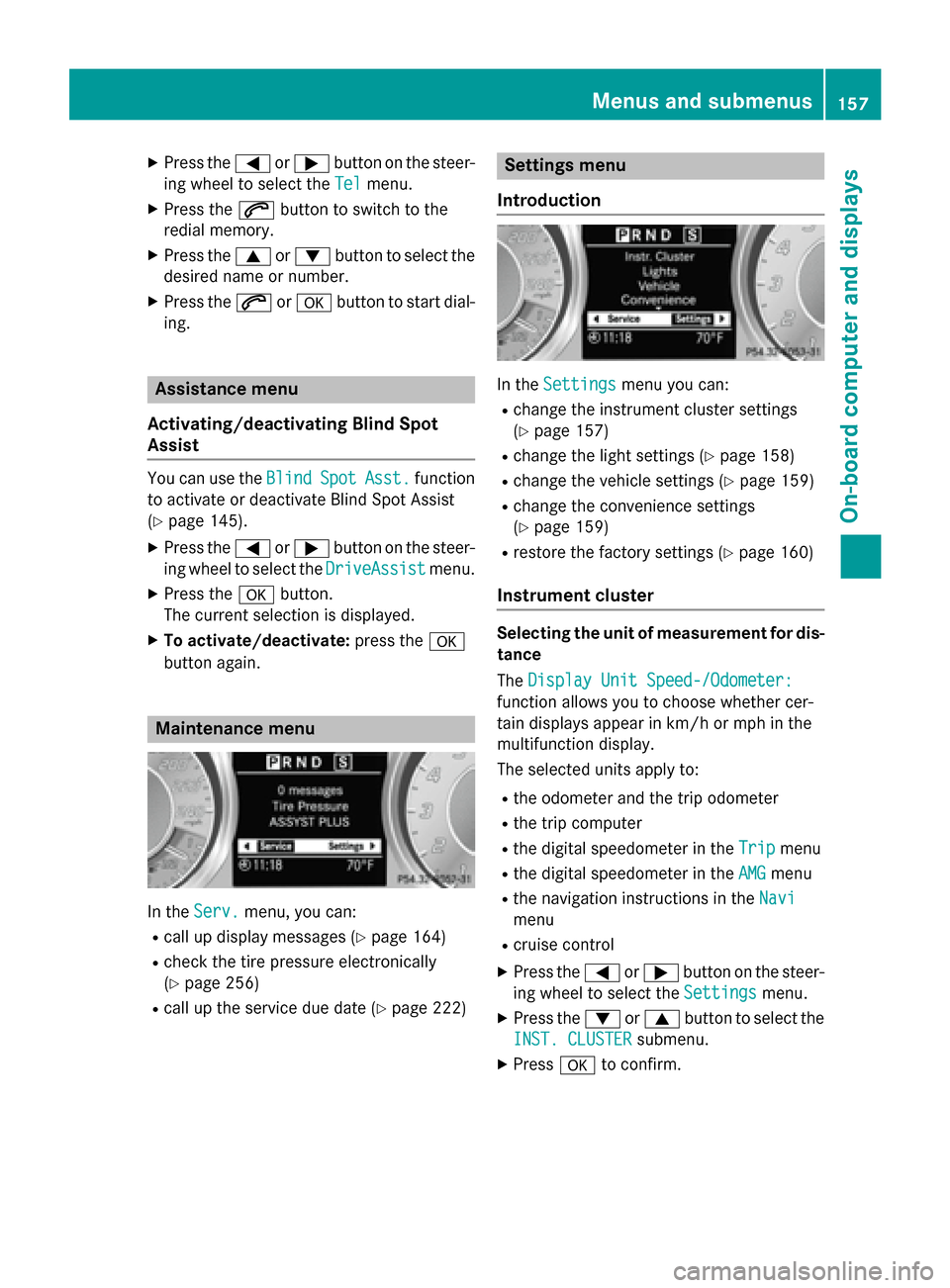
X
Press the 0059or0065 button on the steer-
ing wheel to select the Tel Telmenu.
X Press the 0061button to switch to the
redial memory.
X Press the 0063or0064 button to select the
desired name or number.
X Press the 0061or0076 button to start dial-
ing. Assistance menu
Activating/deactivating Blind Spot
Assist You can use the
Blind BlindSpot
SpotAsst.
Asst. function
to activat eordeactivate Blind Spot Assist
(Y page 145).
X Press the 0059or0065 button on the steer-
ing wheel to select the DriveAssist
DriveAssistmenu.
X Press the 0076button.
The curren tselection is displayed.
X To activate/deactivate: press the0076
button again. Maintenance menu
In the
Serv.
Serv. menu, you can:
R call up display messages (Y page 164)
R check the tire pressure electronically
(Y page 256)
R call up the service due date (Y page 222) Settings menu
Introduction In the
Settings Settings menu you can:
R change the instrument cluster settings
(Y page 157)
R change the light settings (Y page 158)
R change the vehicle settings (Y page 159)
R change the convenienc esettings
(Y page 159)
R restor ethe factory settings (Y page 160)
Instrument cluster Selecting the unit of measurement for dis-
tance
The Display Unit Speed-/Odometer:
Display Unit Speed-/Odometer:
function allows you to choose whether cer-
tain displays appear in km/ho rmph in the
multifunction display.
The selected units apply to:
R the odometer and the trip odometer
R the trip computer
R the digital speedometer in the Trip
Trip menu
R the digital speedometer in the AMG AMGmenu
R the navigation instruction sintheNavi
Navi
menu
R cruise control
X Press the 0059or0065 button on the steer-
ing wheel to select the Settings
Settingsmenu.
X Press the 0064or0063 button to select the
INST. CLUSTER
INST. CLUSTER submenu.
X Press 0076to confirm. Menus and submenus
157On-board computer and displays Z
Page 184 of 290
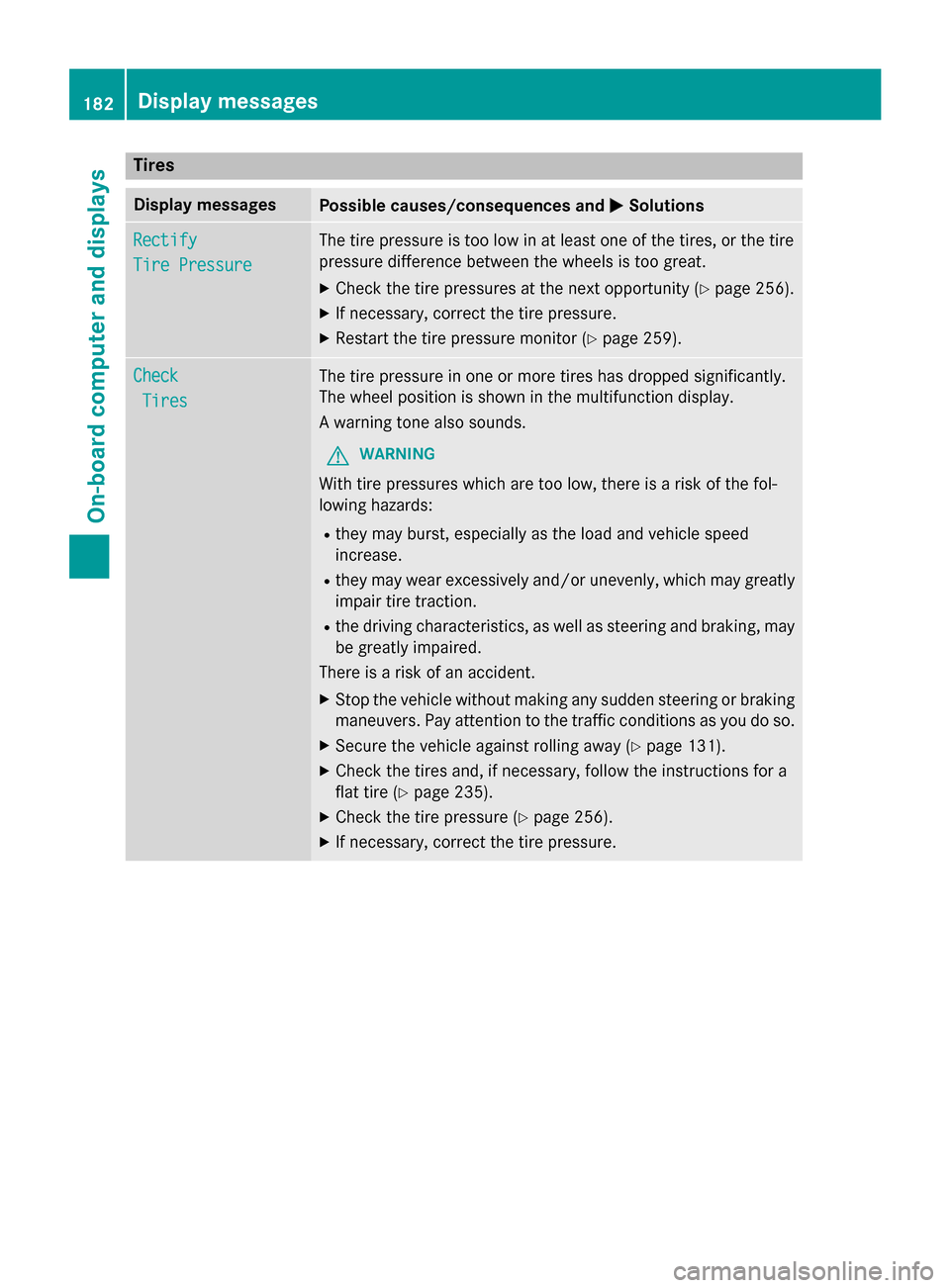
Tires
Display messages
Possible causes/consequence
sand 0050
0050Solutions Rectify
Rectify
Tir
ePressure
Tir ePressure The tire pressure is too lo
winatleastone of the tires, or the tire
pressure difference between the wheels is too great.
X Check the tire pressures at the next opportunity (Y page 256).
X If necessary ,correct the tire pressure.
X Restart the tire pressure monitor (Y page 259).Check Check
Tires
Tires The tire pressure in one or mor
etiresh asdropped significantly.
The whee lposit ioni ss hown in the multifunctio ndisplay.
Aw arnin gtone also sounds.
G WARNING
With tire pressures which ar etoo low, ther eisariskoft he fol-
lowing hazards:
R they ma yburst, especiall yasthe load and vehicl espeed
increase.
R they ma yweare xcessivel yand/or unevenly, which ma ygreatly
impai rtire traction.
R the driving characteristics, as well as steering and braking ,may
be greatl yimpaired.
There is ariskofana ccident.
X Stop the vehicl ewithou tmaking any sudden steering or braking
maneuvers. Pa yattentio ntothe traffi cconditions as yo udoso.
X Secure the vehicl eagain st rolling away (Y page 131).
X Check the tire sand,ifn ecessary ,follo wthe instructions for a
fla ttire (Y page 235).
X Check the tire pressure (Y page 256).
X If necessary ,correct the tire pressure. 182
Displa
ymessagesOn-b oardcomputer an ddisplays